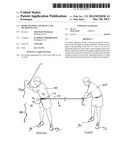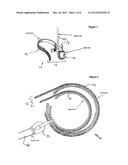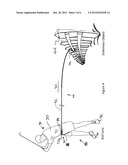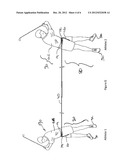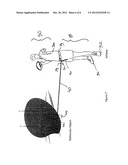Patent application title: SPORT TRAINING APPARATUS AND METHOD OF USE
Inventors:
John Daniel Brannagan (Burlington, CA)
Assignees:
DANBREE CORPORATION
IPC8 Class: AA63B6900FI
USPC Class:
434247
Class name: Education and demonstration physical education
Publication date: 2012-12-20
Patent application number: 20120322038
Abstract:
A training apparatus having a harness mountable about a user's waist and
thigh and a pull securable to the harness at a region corresponding to
the iliac of a crest of the user for pulling the harness to encourage or
resist turning of the user's hips to respectively teach or strengthen
weight transfer from a back foot to a front foot of the user. A method is
provided for training a person in an activity requiring transfer of
weight and momentum from a lower area to an upper area of a person.Claims:
1. A method of training a person in an activity requiring transfer of
weight and momentum from a lower area to an upper area of the person
comprising the steps of: (i) securing a pull to an area corresponding to
an iliac crest of a trailing hip of the person; (ii) having said person
commence said activity; and, (iii) applying force to said pull to (a)
urge said person's hips to turn to encourage weight transfer motion from
a back foot to a front foot of said person in coordination with said
activity or to (b) resist the turning of person's hips to strengthen the
weight transfer motion.
2. A training instruction kit comprising: a harness mountable about a user's waist and thigh; a pull securable to said harness at a region corresponding to the iliac crest of a hip of said user for pulling said harness to encourage or resist turning of the user's hips to respectively teach or strengthen weight transfer from a back foot to a front foot of said user; and, a set of instructions incorporating the method steps of claim 1.
3. The training instruction kit of claim 2 wherein at least a section of said pull is resilient.
4. The training instruction kit of claim 3 wherein said section is exchangeable for another section having a different resiliency.
5. The training instruction kit of claim 4 wherein said section comprises indicia indicative of a degree of resiliency.
6. The training instruction kit of claim 2 wherein said harness comprises a waist strap secured to a thigh strap; and, said waist strap and thigh strap are each provided with interengaging securement means for securing said waist strap and said thigh strap firmly about said user's waist and thigh respectively.
7. The training instruction kit of claim 6 wherein said pull comprises a cord or strap and at least a section of said pull is resilient.
8. The training instruction kit of claim 7 wherein said section is releasably connected to a remainder of said strap.
9. The training instruction kit of claim 7 wherein said pull has a proximal end proximal to said harness and a distal end distal to said harness and wherein said distal end is provided with a securing means for securing said distal end to an object, person or apparatus.
10. The training instruction kit of claim 3 wherein said pull comprises a cord or strap.
Description:
CROSS REFERENCE TO RELATED APPLICATION
[0001] This application claims the benefit of U.S. Provisional Application No. 61/497,693, filed Jun. 16, 2011 which is incorporated by reference as if fully set forth.
FIELD OF INVENTION
[0002] The present invention relates generally to sports training equipment and more particularly to sports training equipment for teaching correct hip rotation for transferring force and momentum from one's lower body to one's upper body.
BACKGROUND OF THE INVENTION
[0003] Success in many sports requires the precise use of a powerful motion to propel a ball or object, either by throwing it, kicking it or by using an implement (e.g. racquet, club or bat) to strike it. Though the sports can be quite diverse (e.g., golf, tennis, hockey, football and baseball), there are significant similarities in the biomechanics and kinesiology of how power is generated and applied within the throwing, kicking and hitting skills characteristic of these sports.
[0004] There are several key principles of effective power generation in kicking, throwing and hitting motions. First, one must have a stable base, or platform, from which to generate power. Lower body balance, and control of the transfer of weight and momentum are vital for delivering force in the desired direction. Throwing and hitting motions are generally initiated by shifting the majority of one's weight from the back foot and leg forward to the lead foot. The weight transfer is essential in maximizing power, via summation of forces, torque and length of lever biomechanical properties. The key is to have an integrated and fluid movement involving as many joints as possible generating a maximum amount of power to hit or throw an object. Kicking requires a similar transfer of power from the lower body via the object. Maximizing hip thrust will impart a greater force on to the object.
[0005] A key area where this fluid movement chain is broken is the transfer of power from the lower body to upper body area. If there is no fluid transfer from the lower body to the upper body, then all of the power generated from the lower body (the strongest muscles in the body) will be negated. This means that one's skill will only be completed with the power of their upper body. This is also a cause of throwing injuries, as people often use only their arms to throw, as opposed to their entire body.
[0006] The benefit of coordinating lower body and upper body (trunk) movements is that it maximizes axial rotation, or rotation around the spine. This translates into shoulder turn, which generates power. The differential rotation of the shoulders relative to rotation of hips and lower body is one key to generating maximum stored (potential) energy.
[0007] Arms perform widely different functions depending on the sport, but there are three principles that pertain to generating power. First, in the preparation or windup phase of the motion, the arms must remain as tension-free as possible. Second, external rotation of the humerus at the shoulder is a key ingredient for matching the efforts of the body and arms (and therefore the implement). The position and function of the wrist must be maintained into a hitting or throwing zone. These three characteristics, to be detailed later, are essential to a number of hitting, kicking and throwing motions that are the foundation of many sports.
[0008] The initiation of a forward, or downswing, comes next, after the upper body is coiled upon the more stable lower body. Amateurs struggle mightily with this. If they haven't lost their ideal position on the backswing, most lose it immediately at the beginning of the downswing. Professionals seem to harness and deliver power with seemingly little effort. What's the difference?
[0009] Efficiently generating power in a forward swing or throw requires several things. First, weight must be transferred to the forward foot while maintaining balance and a stable platform. Second, rapid hip rotation commences, during and in conjunction with continued weight shift, effectively increasing the differential rotation between the shoulders and lower body. This produces "lag", i.e., a stretching of the muscles in the side and back between the upper torso and the hips, which is the key to preserving the potential energy of the backswing. Third, the arms, moving in unison with the body as it uncoils, are whipped through the throwing/hitting zone, thereby increasing club head/racquet/hockey stick/bat/ball/speed. Fourth, by not trying to manipulate the hands or implement through contact, a full and unrestricted follow through can ensue to complete the motion.
[0010] To date, no individual sport swing training apparatus has adequately addressed the key issues of power discussed above. More specifically, no hitting, kicking and/or throwing training device on the market attempts to train for multiple sports by harnessing the proper sequence of joint and muscle forces for generating and applying power.
[0011] Hundreds of devices have been invented to help people with their swings in sports. They are sport specific, and the vast majority are golf devices. None have been devised to correctly harness power, reinforce the proper sequence in applying it, and adapt to multiple sports.
SUMMARY
[0012] A method of training a person in an activity requiring transfer of weight and momentum from a lower area to an upper area of the person. The method comprises the steps of:
[0013] (i) securing a pull to an area corresponding to an iliac crest of a trailing hip of the person;
[0014] (ii) having the person commence the activity; and,
[0015] (iii) applying force to the pull to either (a) urge the person's hips to turn to encourage weight transfer motion from a back foot to a front foot of the person in coordination with the activity or to (b) resist turning of the person's hips to strengthen the weight transfer motion.
[0016] A training apparatus for use in the above method is provided having a harness mountable about a user's waist and thigh and a pull securable to the harness at a region corresponding to the iliac crest of a hip of the user for pulling the harness to encourage turning of the user's hips to facilitate weight transfer from a back foot to a front foot of the user. The training apparatus may be in a kit also including instructions as to the above method.
[0017] At least a section of the pull may be resilient.
[0018] The resilient section may be exchangeable for another resilient section having different resiliency.
[0019] The resilient section may have markings indicative of a degree of resiliency.
[0020] The harness may comprise of a waist strap secured to a thigh strap.
[0021] The waist strap and thigh strap may each be provided with interengaging securement means for securing the waist strap and the thigh strap firmly about the user's waist and thigh respectfully.
[0022] The pull may have a proximal end proximal the harness and a distal end distal the harness and the distal end may be provided with a securing means for securing the distal end to an object, person or other sport training apparatus.
[0023] The pull may comprise a strap.
BRIEF DESCRIPTION OF THE DRAWINGS
[0024] These and other features of the invention will become more apparent from the following description in which reference is made to the appended drawings wherein:
[0025] FIG. 1 is a perspective view of an apparatus according to the present invention;
[0026] FIG. 2 is a top plan view corresponding to FIG. 1;
[0027] FIG. 3 is a perspective view of an apparatus according to the present invention in use;
[0028] FIG. 4 is a perspective view of an apparatus according to the present invention in use;
[0029] FIG. 5 is a further view of an apparatus according to the present invention in use;
[0030] FIG. 6 is a perspective view of an apparatus according to the present invention in use in a strength training application; and,
[0031] FIG. 7 is a perspective view of an apparatus according to the present invention in use in yet another strength training application.
DETAILED DESCRIPTION OF THE PREFERRED EMBODIMENTS
[0032] A training apparatus according to the present invention is generally indicated by reference numeral 10 in the accompanying illustrations. The training apparatus 10 has a harness 12 comprising a waist strap 14 and a thigh strap 16. Each of the waist strap 14 and thigh strap 16 are provided with interengaging securement means 18 and 20 respectively such as the hook and loop fastener illustrated or suitable alternatives such as a buckle arrangement, a cinchable strap, dome fasteners, etc., for securing the waist strap 14 and 16 firmly about the waist and thigh of a user 30.
[0033] Although straps are illustrated and described, it will be appreciated that the harness may take other forms, such as, for example, a pant or girdle type of arrangement. The harness is intended to enable mounting of a pull 40 to a region 50 corresponding to iliac crest of the user 30 to enable guiding of the hip by pulling on the pull 40. Accordingly, any mounting/securing arrangement conducive to such a purpose may be utilized. Straps, while likely the simplest arrangement, are not necessarily the only arrangement as will be appreciated by those skilled in the art.
[0034] The pull 40 would typically be pulled on by an instructor such as a coach 60 illustrated or another athlete skilled in the activity being taught. The pull 40 may be entirely or in part resilient for example by including a resilient section 42. If the pull 40 is resilient, it may be attached to an immovable object such as a fence 62 illustrated in FIG. 4 or goal post 64 illustrated in FIG. 7. Alternatively, the pull 40 may be connected to another harness 12 worn by an instructor 66 skilled in the activity being taught.
[0035] In order to enable attachment of the pull 40 to an immovable object such as the fence 62 or goal post 64, the pull 40 may be provided with securing means 70 at a distal end 72 thereof distal the harness 12. A proximal end 74 of the pull 40 is secured to the harness 12. The securing means may for example be a buckle, a hook and loop fastening arrangement or dome fasteners. Alternatively, the securing means may simply involve tying the distal end 72 about the immovable object.
[0036] The resilient section 42 may be exchangeable for a different resilient section 42 with a different resiliency. The different resilient sections 42 may be marked, for example, by banding or colour coding, to indicate different resiliencies. The remaining section of the pull 40 which is non-resilient may comprise a strap.
[0037] In use, a coach 60 or skilled person 66 uses the apparatus 10 to teach transfer of weight and momentum from a lower area 80 to an upper area 90 of the user 30. This is accomplished by securing the pull 40 to the area 50 corresponding to the iliac crest of a trailing hip of a person/user 30.
[0038] Next, the user 30 commences the activity which would typically be throwing an object or striking with a club, racquet, bat, a stick, etc.
[0039] The coach 60 or skilled person 66 would then apply a force to the pull 40 to urge the person/user's 40 hips to turn to encourage weight transfer motion from a back foot 90 to a front foot 92 of the person 30 in coordination with the activity. This is shown in FIGS. 3, 4 and 5 where the pulling force is from in front of the person.
[0040] Once the person has learned the desired motion, a resistive force may be applied to the pull 40 to resist the person's hips from turning to strengthen the weight transfer motion. This is illustrated in FIGS. 6 and 7 where the pulling force is from behind.
[0041] The above description is intended in illustrative rather than a restrictive sense. Variations may be apparent to persons skilled in the art without departing from the scope of the invention as defined by the claims set out below.
User Contributions:
Comment about this patent or add new information about this topic:
| People who visited this patent also read: | |
| Patent application number | Title |
|---|---|
| 20130179310 | INFORMATION PROCESSING APPARATUS, CONSUMABLES STOCK MANAGEMENT SYSTEM, CONSUMABLES STOCK MANAGING METHOD, CONSUMABLES STOCK MANAGING PROGRAM, AND MEMORY MEDIUM |
| 20130179309 | Methods and Systems For Restocking Inventory |
| 20130179308 | Methods and Systems Related to Monetization Plug-Ins in Interactive Multimedia Applications |
| 20130179307 | Methods And Systems For Restocking Inventory |
| 20130179306 | MOBILE COMPUTING DEVICE CONFIGURED TO EXECUTE A MULTI-DIMENSIONAL FUNCTION PRESENTED ON A VISUAL MEDIA |

